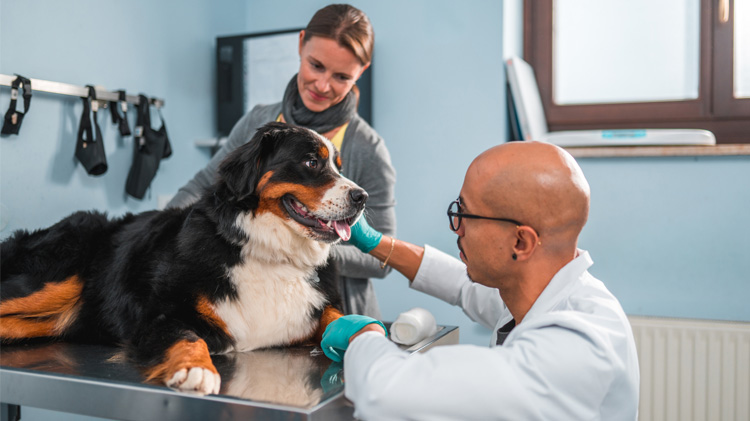Pet parasites
Help protect your dog or cat from fleas, ticks and heartworms.
Pets bring endless joy into our lives, but they can also bring home all sorts of parasites. Besides making your skin crawl, parasites can cause anything from mild discomfort all the way to death. But that’s not all, some parasites can cause real health problems for their human families.
Parasites are common and, depending on where you live, some can be found almost anywhere year-round, making them a risk to all unprotected dogs and cats. In fact, most pets will contract a parasite at least once during their lifetime. Contrary to popular belief, there is no such thing as an outdoor-only parasite. Learn how to help protect your pet from 3 common parasites, as well as how to deal with a parasitic infestation.
Flea, tick and heartworm prevention for dogs and cats
What are fleas?
Fleas are tiny, wingless insects that feed on the blood of an animal or human host. Their bites produce an allergic skin reaction, which can cause inflammation of the skin, excessive itching/irritation, and in some cases, tapeworm, and even anemia. They reproduce and multiply rapidly, so they can quickly make your pet’s and your own life miserable if left untreated.
Even though fleas are common in warmer climates and during the summer months, they can thrive indoors with your family, basking in the heated comfort of your home during the winter.
How do dogs and cats get fleas?
Pets typically get fleas from the environment or from other pets. That said, they can be found anywhere outdoors, including in trees, shrubs, tall grass, and even your own backyard. Animals such as raccoons and squirrels can spread fleas just by walking through your yard. Fleas also like dark, moist and warm areas like leaf piles and yard waste.
According to FleaScience, fleas are excellent jumpers and can jump up to 7.9 inches high and up to 19 inches in distance. They’ll normally enter your home by jumping on you, your clothes or your pet, but fleas can also jump through screen doors and windows.
Signs of fleas in dogs and cats
Due to their small size, it can take some time before fleas are noticeable, especially if a pet has long, thick or dark fur. Here’s what to look for:
- Tiny black or brown dots on your pet, furniture, rugs, carpet or bedding
- White oval-shaped eggs
- “Flea dirt,” which looks like coffee grounds
- Excessive itching, scratching and self-biting
- Hair loss
- Red dots and irritated skin from fleabites
How to help get rid of fleas
Fleas can be challenging to get rid of due to their long and complex lifecycle. Flea eggs, flea larvae, flea pupae and flea adults require a multi-pronged approach to effectively eliminate. Prevention may be easier than cure.
The sooner you address a flea infestation, the better. Consider these steps to help get rid of those pesky pests:
- Clean and sanitize your home. To help get rid of flea eggs and juvenile fleas, thoroughly clean and wash all bedding, rugs, soft toys, clothing, beds, cushions, and blankets in hot water. Anything soft or plush in your home needs to be washed. In addition, it’s important to deep clean your home on an ongoing basis. This can include vacuuming and sanitizing all floors, carpets, walls and surfaces. Fleas can take months to fully get rid of, so try to stay vigilant!
- Treat and bathe all pets. If one pet has fleas, all pets in the home need to be treated. Completely bathe all pets from nose to tail using warm water and any appropriate products recommended by your veterinarian. Pay extra attention to hard-to-reach areas like your pet’s neck, shoulder blades, the base of their tail, and groin. Treatments come in both topical and oral forms. Talk with your veterinarian to find the treatment that’s the safest and most effective option for your pet. To effectively deal with fleas in all stages of the lifecycle, two or more follow-up treatments may be needed.
What are ticks?
Ticks are tiny, blood-sucking parasites that feed on both animals and humans. They resemble tiny spiders and can be black, brown or tan. Most ticks start small but can quickly grow to the size of a coffee bean as they feed. Ticks can cause mild symptoms, but they can also spread serious diseases and create severe, long-term health problems for pets and their people alike.
How do dogs and cats get ticks?
If you spend time outside with your pet, try to keep an eye out for ticks. They can be found in tall grass, wooded areas, trees and shrubs. They’re most active during the warmer months, but like fleas, don’t completely go away in the winter and your pet's warm body plays a perfect host.
How to spot ticks on dogs and cats
Ticks are usually small, flat and oval-shaped. They’re much easier to spot once they’re swollen with blood because they can grow much larger in size. Due to their appearance and color, ticks are commonly mistaken as a wart or skin tag.
After spending time outside with your pet, run your hands through their fur and feel for any lumps or bumps. Check thoroughly and pay attention to your pet’s head and neck area.
How to remove ticks
If you find a tick, it’s important to remove it appropriately, either by your veterinarian or under your veterinarian’s guidance when possible. If you can't get in to see your vet, try to photograph the tick(s) and affected area for identification and any needed follow up. Where there is one there may be more, so have a good look around your pet's body.
- Wet the skin to flatten any surrounding fur. While wearing latex gloves, use a tick removal tool (available online or in most pet supply stores) to take hold of the tick as close to your pet’s skin as possible.
- Gently pinch the skin below the tick, twist, and pull straight up in a slow motion. You want the tick to let go instead of having to pull it off.
- Avoid squeezing or jerking the tick away too quickly. The last thing you want is to leave any part of the tick behind. This increases the chances of disease and infection. Place the live tick in a small, lidded jar or sealed container containing rubbing alcohol for disposal.
- If you notice a dark dot after removing the tick, the head is likely still stuck in your pet’s skin. Call your veterinarian or schedule an appointment as soon as you can to help prevent infection.
What are heartworms?
Of all the different parasites, heartworms can be one of the most dangerous and deadly. They live in a pet’s bloodstream and can grow up to a foot long. These parasitic worms cause heartworm disease, which can start as a mild, persistent cough and progress to severe lung disease, heart failure and other organ damage.
How do dogs and cats get heartworms?
Heartworms are transmitted by mosquitoes. As annoying as these flying insects might be, they can be more than just a nuisance. Along with causing itchy red bumps, mosquitoes can spread serious diseases, including heartworm.
Heartworm poses a much greater threat to pets than humans, as heartworm disease is relatively rare in humans. While mosquitos are most active during the summer months and in tropical areas, they can be active year-round. Mosquitoes can also find their way into your home, so even indoor pets aren’t completely safe from heartworm.
Signs of heartworm in pets
In the early stages of heartworm disease, many pets show little to no signs or symptoms. Heartworms can live undetected in a pet’s body for a few years, slowly damaging the lungs and heart until more obvious signs appear.
As the disease progresses, things to watch out for include:
- Persistent coughing
- Severe weight loss
- Lack of stamina
- Disinterest in physical exercise
- Labored breathing
- Drowsiness
- Loss of appetite
- Fatigue and lethargy
- Loss of consciousness
Heartworm treatment for dogs and cats
Pets tend to have advanced heartworm disease by the time they’re diagnosed, which can be very difficult, dangerous and expensive to treat. Heartworm treatment for dogs can involve surgery, multiple medications, antibiotics and injections. Once the heartworms are killed, some dogs may also need lifelong care and treatment for organ damage and failure.
Unfortunately, there’s no approved drug therapy for cats who test positive for heartworms. Instead, treatment is focused on treating their symptoms and reducing any pain or discomfort.
How to prevent fleas, ticks, heartworm and other pet parasites
Fortunately, there are many ways to help protect your pet. Here’s how:
- Consider using monthly flea, tick and heartworm preventives year-round, not just during the summer months.
- Schedule annual check-ups with your veterinarian.
- Practice good hygiene and always clean up after your pet. Many internal parasites are transmitted through feces.
- Check your pet for parasites after playing outside, especially after hiking or camping.
- Visit the Companion Animal Parasite Council to learn about parasites in your area.
- Consider pet insurance to lessen your worries about pet parasites. Pet insurance doesn’t cover parasite prevention, but if your pet needs parasite treatment, pet insurance can help. By having coverage for unexpected veterinary expenses, you can focus on your pet’s care instead of your finances.
Additional sources:
https://www.trupanion.com/pet-blog/article/how-to-get-rid-of-fleas
https://www.humanesociety.org/resources/what-do-if-you-find-tick-your-dog
https://www.trupanion.com/pet-blog/article/heartworms-in-pets
https://vcahospitals.com/know-your-pet/heartworm-disease-in-dogs---treatment





